Introduction
Ontario conducts its borrowing program responsibly and prudently to manage interest on debt (IOD) costs.
Ontario completed $41.1 billion in long-term borrowing in 2021–22. This is $13.5 billion lower than anticipated in the 2021 Budget forecast, primarily due to lower deficits in fiscal years 2020–21 and 2021–22. The 2022–23 long-term public borrowing forecast is $41.5 billion, a further decrease of $17.6 billion from the 2021 Budget forecast.
Ontario is forecast to pay $13.0 billion in interest costs in 2021–22, and $13.5 billion in 2022–23, down from the 2021 Budget forecasts of $13.1 billion and $13.7 billion, respectively.
Ontario’s net debt-to-GDP ratio is now forecast to be 40.7 per cent in 2021–22, and 41.4 per cent in 2022–23, down 8.1 and 8.2 percentage points, respectively, from the forecasts of 48.8 per cent and 49.6 per cent in the 2021 Budget.
Ontario’s net debt-to-revenue is forecast to be 228 per cent in 2021–22 and 238 per cent in 2022–23, a decrease of 58 percentage points and 59 percentage points, respectively, from the 2021 Budget forecast.
Ontario’s interest on debt-to-revenue is forecast to be 7.5 per cent in 2021–22 and 2022–23, a decrease of 1.0 percentage point and 1.1 percentage points, respectively, from the 2021 Budget forecast.
Borrowing Program
Ontario’s borrowing program is primarily used to fund deficits, refinance maturing debt and make investments in capital assets. Ontario will continue to finance most of its borrowing program in the long-term public markets in Canada and internationally.
| 2021–22 — 2021 Budget |
2021–22 — Change from 2021 Budget |
2021–22 — Interim1 2021–22 |
Medium-Term Outlook 2022–23 |
Medium-Term Outlook 2023–24 |
Medium-Term Outlook 2024–25 |
|
|---|---|---|---|---|---|---|
| Deficit/(Surplus) | 33.1 | (19.6) | 13.5 | 19.9 | 12.3 | 7.6 |
| Investment in Capital Assets | 11.8 | 1.0 | 12.9 | 13.4 | 13.6 | 14.8 |
| Non-Cash Adjustments | (9.5) | 1.1 | (8.4) | (9.7) | (9.6) | (10.5) |
| Loans to Infrastructure Ontario | 0.2 | 0.0 | 0.3 | (0.1) | 0.2 | 0.0 |
| Other Net Loans/Investments | 1.3 | (1.4) | (0.1) | 0.7 | (0.1) | (0.9) |
| Debt Maturities/Redemptions | 25.0 | 0.0 | 25.0 | 30.5 | 31.2 | 27.8 |
| Total Funding Requirement | 61.9 | (18.9) | 43.1 | 54.7 | 47.6 | 38.9 |
| Decrease/(Increase) in Short-Term Borrowing | (6.0) | 6.0 | – | (3.0) | (3.0) | – |
| Increase/(Decrease) in Cash and Cash Equivalents | 4.0 | – | 4.0 | – | – | – |
| Pre-borrowing in 2020–21 for 2021–22 | (5.2) | (10.9) | (16.2) | – | – | – |
| Pre-borrowing for 2022–23 | – | 10.3 | 10.3 | (10.3) | – | – |
| Total Long-Term Public Borrowing | 54.7 | (13.5) | 41.1 | 41.5 | 44.6 | 38.9 |
Table 4.1 footnotes:
[1] Interim represents the 2022 Budget projection for the 2021–22 fiscal year.
Note: Numbers may not add due to rounding.
Source: Ontario Financing Authority.
Ontario’s long-term borrowing requirement for 2021–22 decreased by $13.5 billion from the 2021 Budget forecast. This is primarily due to a lower deficit forecast for 2021–22, combined with higher opening cash levels at the beginning of 2021–22 due to lower than planned deficit results for 2020–21. Ontario has completed its long-term public borrowing for 2021–22 of $41.1 billion, including $10.3 billion in pre-borrowing for 2022–23.
The 2021 Budget forecasted an increase of $6.0 billion in short-term borrowing for 2021–22. However, the lower deficits allowed Ontario to leave the amount outstanding in its short-term borrowing program unchanged in 2021–22, a $6.0 billion decrease from the original projection.
The total long-term borrowing requirements for 2021–22 through 2023–24 are now forecast to be a cumulative $41.7 billion lower than forecast in the medium-term outlook in the 2021 Budget. This includes a decrease of $17.6 billion for 2022–23 and $10.6 billion for 2023–24. The long-term borrowing requirement for 2024–25, which was not included in the 2021 Budget, is forecast at $38.9 billion, and would be the lowest long-term borrowing program since 2017–18.
The government will seek approval from the Legislature for borrowing authority to meet Ontario’s requirements.
In the event that alternative economic scenarios materialize, Ontario’s borrowing requirements in the next three years would also change. See Ontario’s Economic and Fiscal Outlook in Brief for more details and a description of the resulting alternative medium-term outlook scenarios. Under the Faster Growth scenario, long-term borrowing would decrease by a total of $22.4 billion over the three-year outlook period, while under the Slower Growth scenario, long-term borrowing would increase by $16.2 billion over the same period.
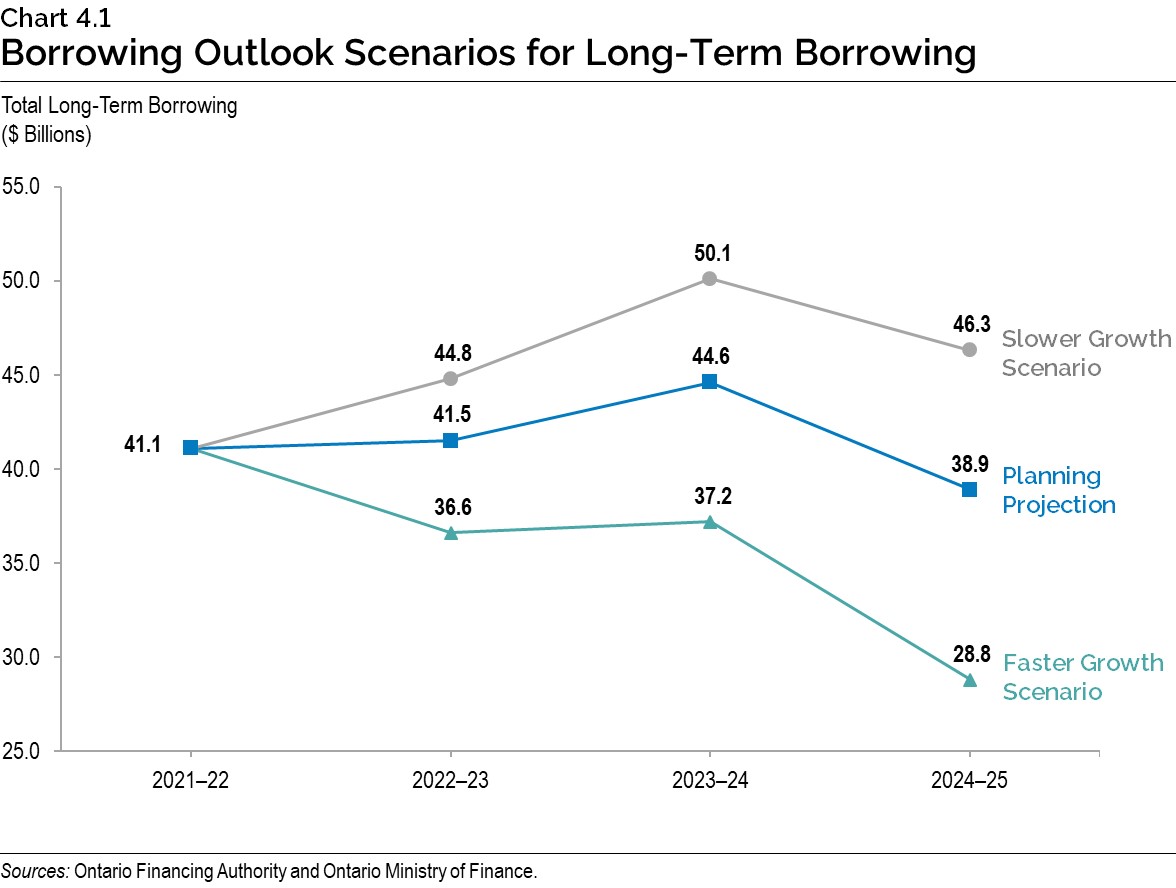
Approximately 78 per cent of 2021–22 borrowing was completed in Canadian dollars primarily through 36 syndicated issues and two Green Bonds. This percentage is near the top end of Ontario’s target range for domestic borrowing of 65 to 80 per cent for the fiscal year. Based on the 2021–22 experience, Ontario plans to retain the same target range for 2022–23 but will adjust, if necessary, in response to evolving investor demand in the Canadian dollar and foreign currency markets.
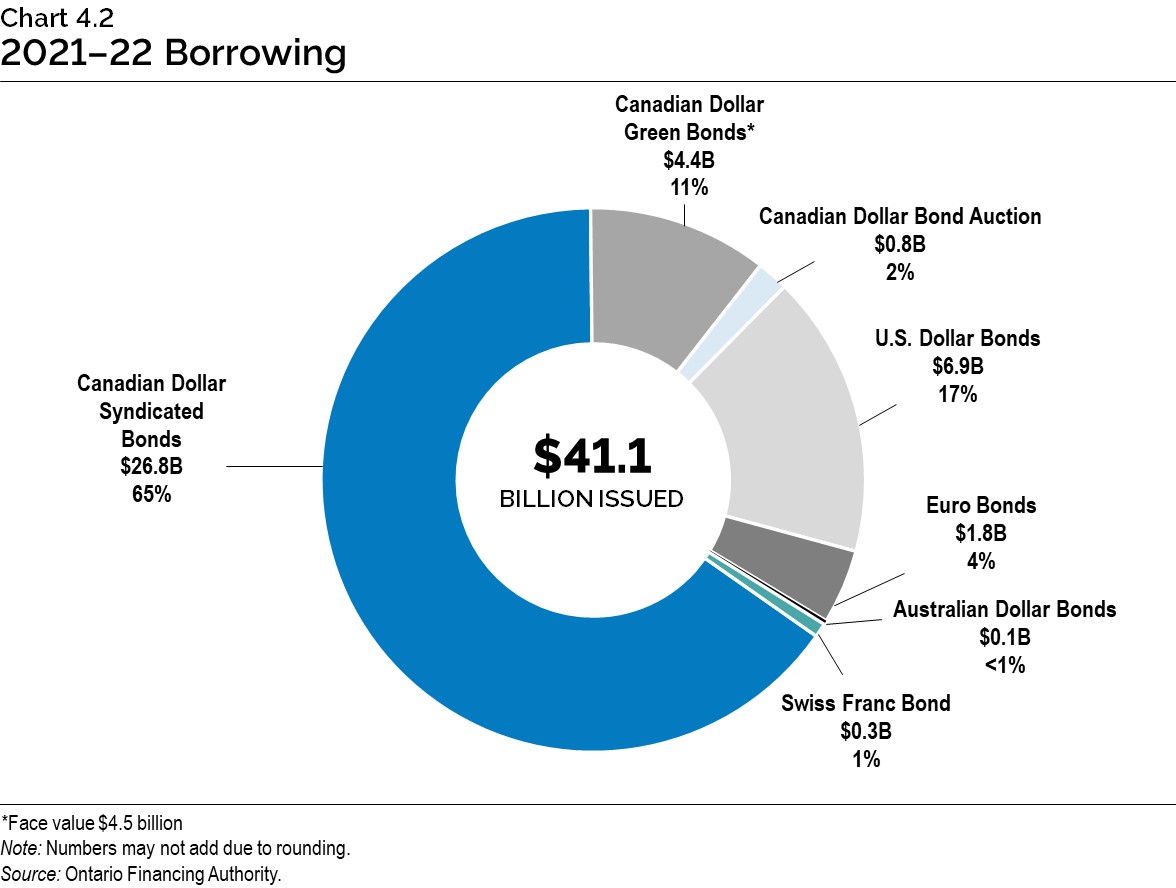
Foreign currency borrowing helps reduce Ontario’s overall borrowing costs by continuing to diversify Ontario’s investor base. This diversification ensures the government will continue to have access to capital even if domestic market conditions become challenging. Approximately $9.2 billion, or 22 per cent of this year’s long-term borrowing, was completed in foreign currencies, primarily in U.S. dollars and euros.
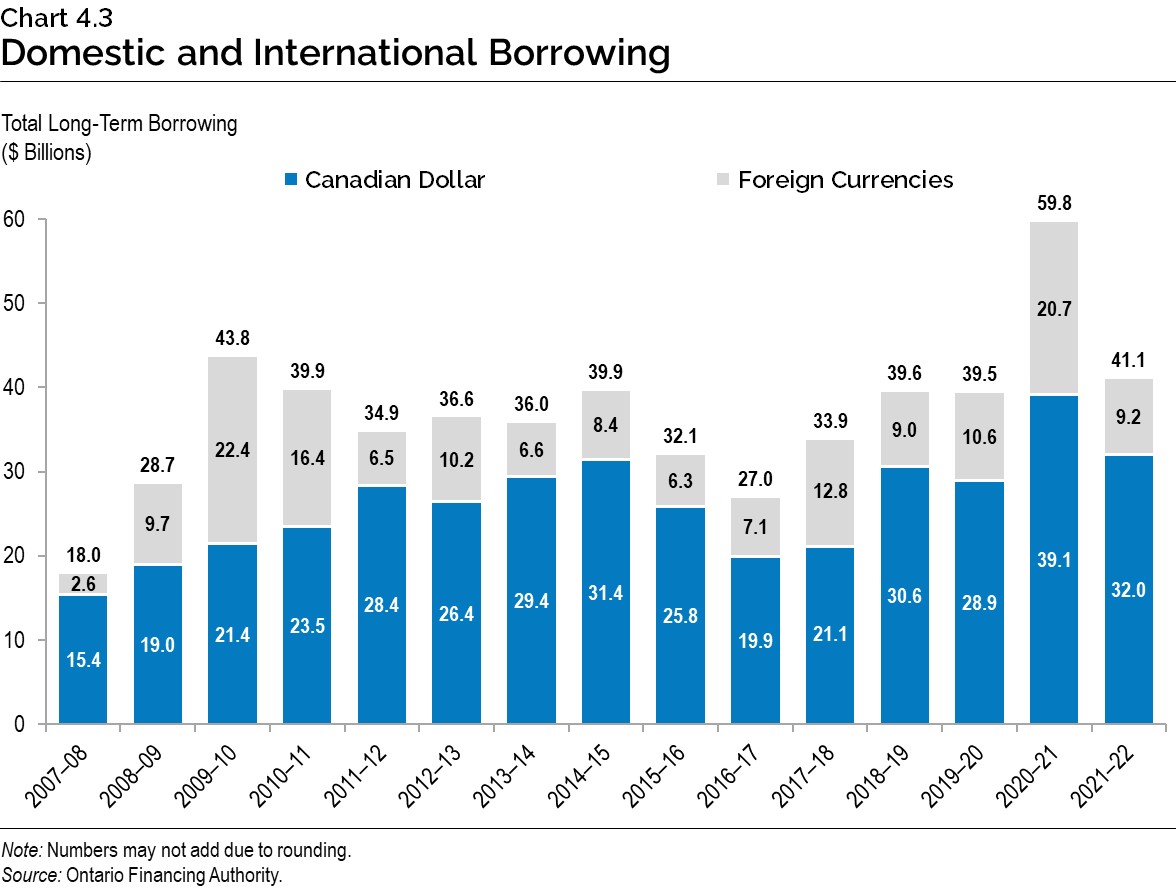
Green Bond Program
Green Bonds remain a core component of Ontario’s borrowing program and are an important tool to help finance public transit initiatives, extreme weather-resistant infrastructure, as well as energy efficiency and conservation projects. Ontario remains the largest issuer of Canadian dollar Green Bonds, totalling $12.5 billion issued since 2014–15, with $12.0 billion outstanding.
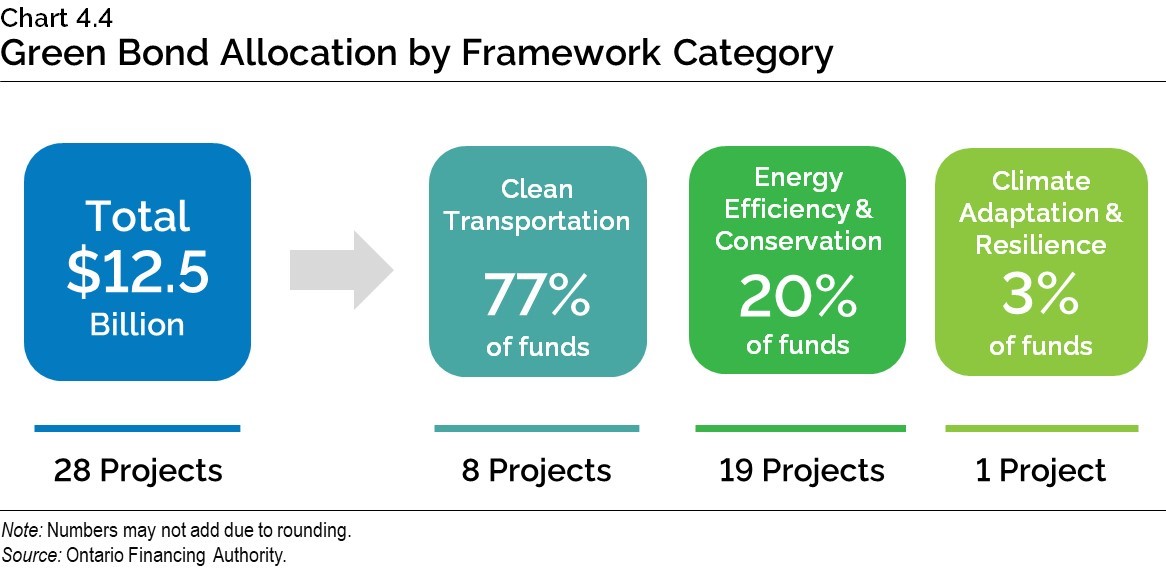
On February 2, 2022, Ontario issued its second Green Bond in 2021–22, and eleventh Green Bond overall. This issue was for $1.75 billion and followed a $2.75 billion issue in July 2021. The total $4.5 billion issued in 2021–22 was the most in any single year since the inception of Ontario’s Green Bond program. Eight projects were selected to receive funding from the most recent Green Bond. This included six Clean Transportation projects, one Energy Efficiency and Conservation project and one project under the Climate Adaptation and Resilience framework category:
- Eglinton Crosstown Light Rail Transit (LRT);
- GO Transit Expansion;
- Finch West LRT;
- Hurontario LRT;
- Ontario Line Subway;
- Scarborough Subway Extension;
- West Park Healthcare Centre; and
- Port Lands Flood Protection.
Ontario is considering updating its Green Bond Framework. The update may include better alignment of framework categories with the Green Bond Principles through standardized wording, as well as the possible expansion from green to sustainable to allow for a greater breadth of potential bond offerings in the future.
Ontario plans to continue its leadership in the Canadian dollar Green Bond market and, subject to market conditions, will issue multiple Green Bonds each fiscal year, including in 2022–23.

Cost of Debt
The three-decade decline in interest rates is beginning to change, as central banks, including the Bank of Canada and the U.S. Federal Reserve, have begun raising overnight interest rates. This will impact Ontario’s interest on debt (IOD) costs. Chart 4.6 shows the declining effective interest rate Ontario is paying on its total debt portfolio.
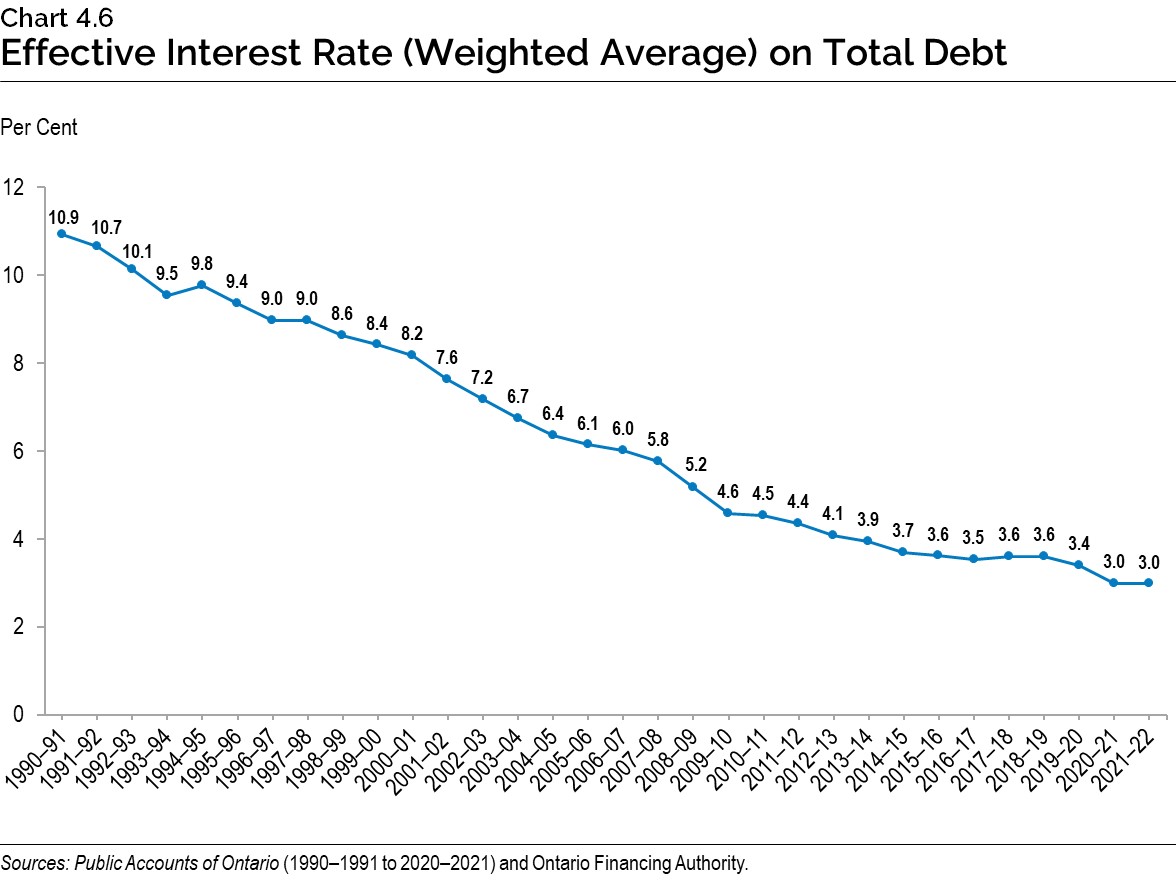
The overall increase in interest rates has resulted in Ontario’s cost of borrowing in 2021–22 going up by 20 basis points from the 1.90 per cent forecast in the 2021 Budget. Ontario’s average cost of borrowing in 2022–23 is forecast to be 3.40 per cent, 100 basis points higher than the forecast for 2022–23 in the 2021 Budget. A one percentage point change in interest rates either up or down from the current forecast is estimated to have a corresponding change in Ontario’s interest costs by over $700 million in the first full year.
Chart 4.7 shows average borrowing rates on debt issued in 2021–22 and the forecast used to estimate the future cost of borrowing or IOD expense.

Lower than forecast deficits and borrowing requirements have reduced Ontario’s IOD costs, in spite of rising interest rates. The IOD forecast for 2021–22 is $13.0 billion, down from the 2021 Budget forecast of $13.1 billion, and remains lower for each year of the medium-term outlook than the IOD forecast contained in the 2021 Budget, as shown in Chart 4.8. However, IOD remains Ontario’s fourth largest expense after health care, education, and children’s and social services. The rising cost of IOD could mean less resources would be available to be allocated to the priorities of the people of Ontario, reinforcing the importance of Ontario’s commitment to responsible fiscal management, including reducing the debt burden and balancing the budget.
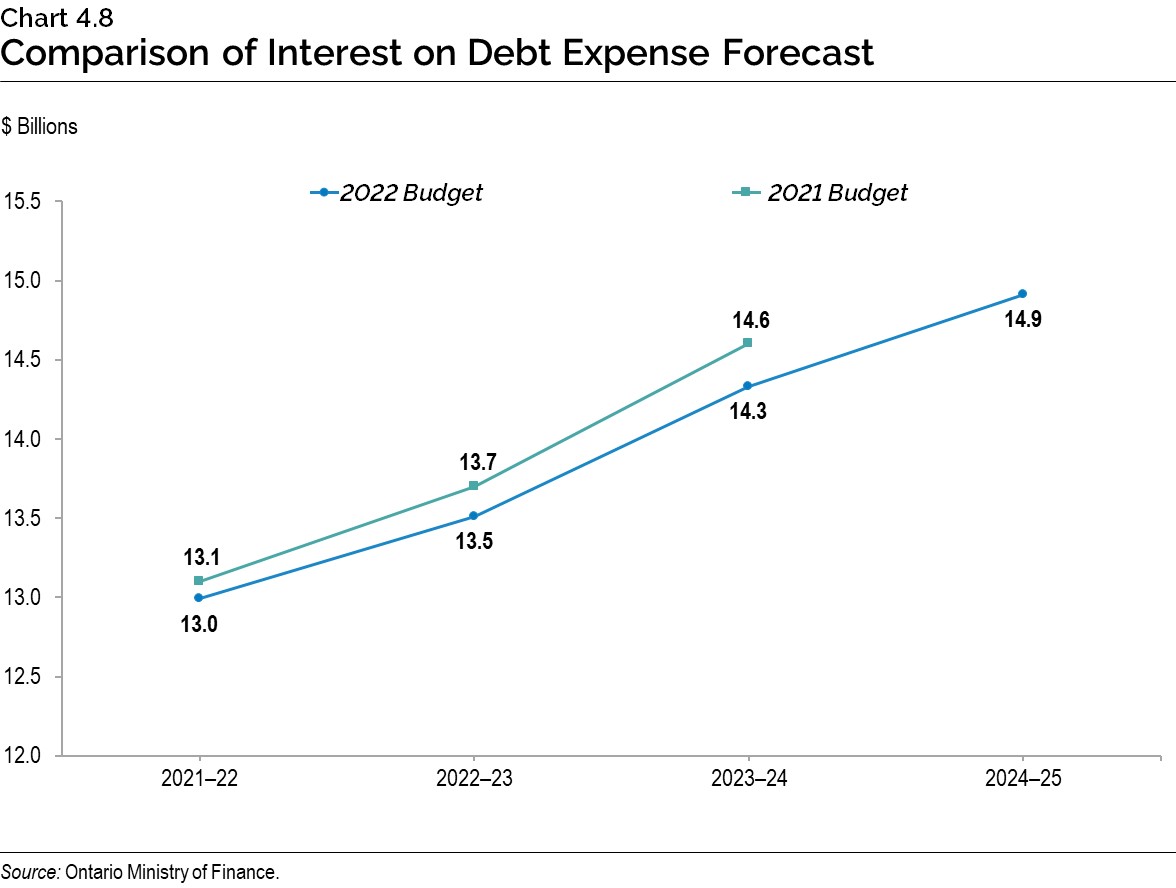
Term of Debt
Ontario has continued to extend the term of its debt, when investor demand allowed, to reduce refinancing risk on maturing debt. This also continues to protect the IOD forecast against increases in interest rates. Ontario has issued $113.9 billion of bonds, or more than one-quarter of total debt, with maturities of 30 years or longer since 2010–11. This includes $10.4 billion in 2021–22.
With interest rates rising but still low compared to the period preceding the global financial crisis in 2007–08, and a large borrowing program and debt portfolio, the current plan is to maintain the term of Ontario’s debt at the level it has been at since 2014–15. The success Ontario has had in extending the term of its debt from the time of the global financial crisis leaves it with flexibility going forward, so the rise in long-term interest rates will be monitored to determine whether a modest change to Ontario’s debt term strategy is appropriate in 2022–23.
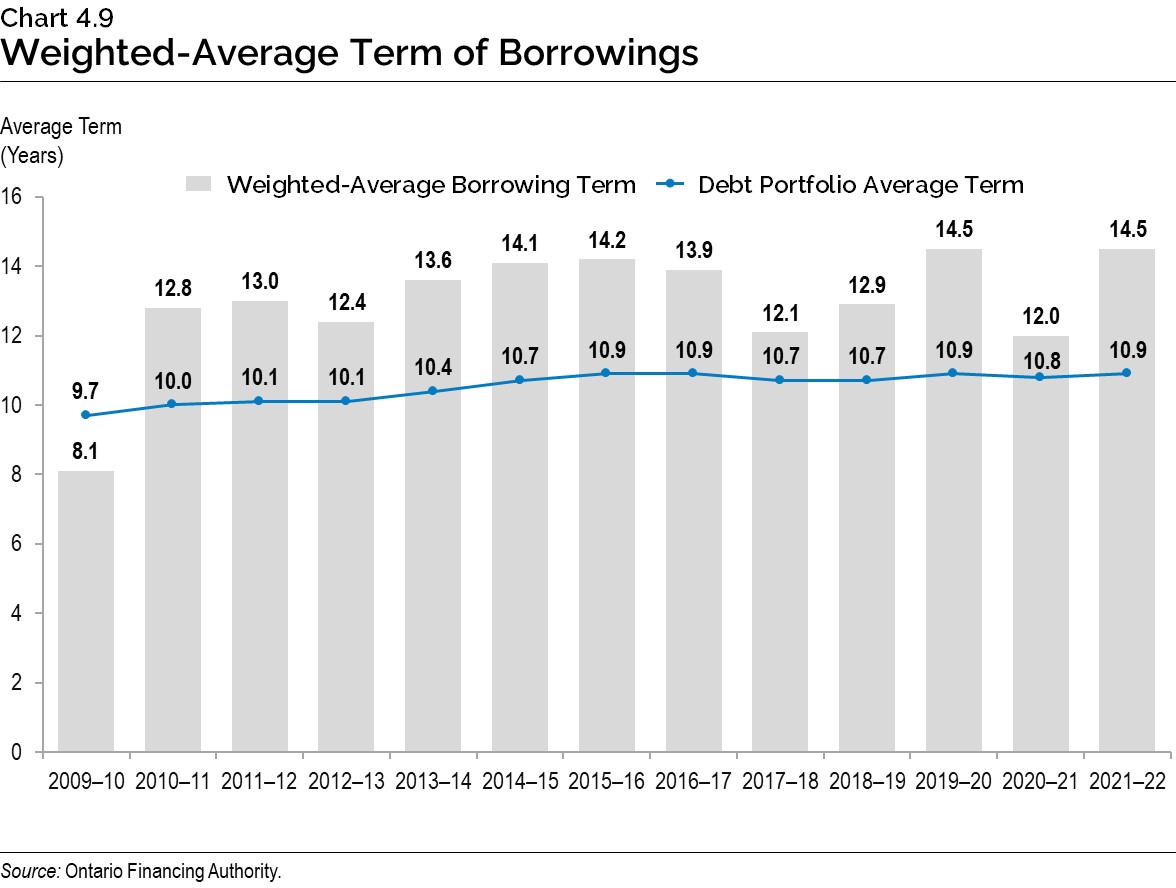
Ensuring Adequate Liquidity Levels
Ontario balances the objective of minimizing the cost of holding liquid reserves against the need to always have enough cash on hand to pay its bills, invest in capital assets, refinance maturing debt and pay interest.
Ontario has built larger cash reserves over the last two years, as depicted in Chart 4.10, in anticipation of the need to meet requirements for large cash outflows on a single day including when maturing benchmark bond issues in excess of $10 billion come due. Cash reserves also allow the government to quickly respond to any unforeseen borrowing market, economic or public health circumstances.
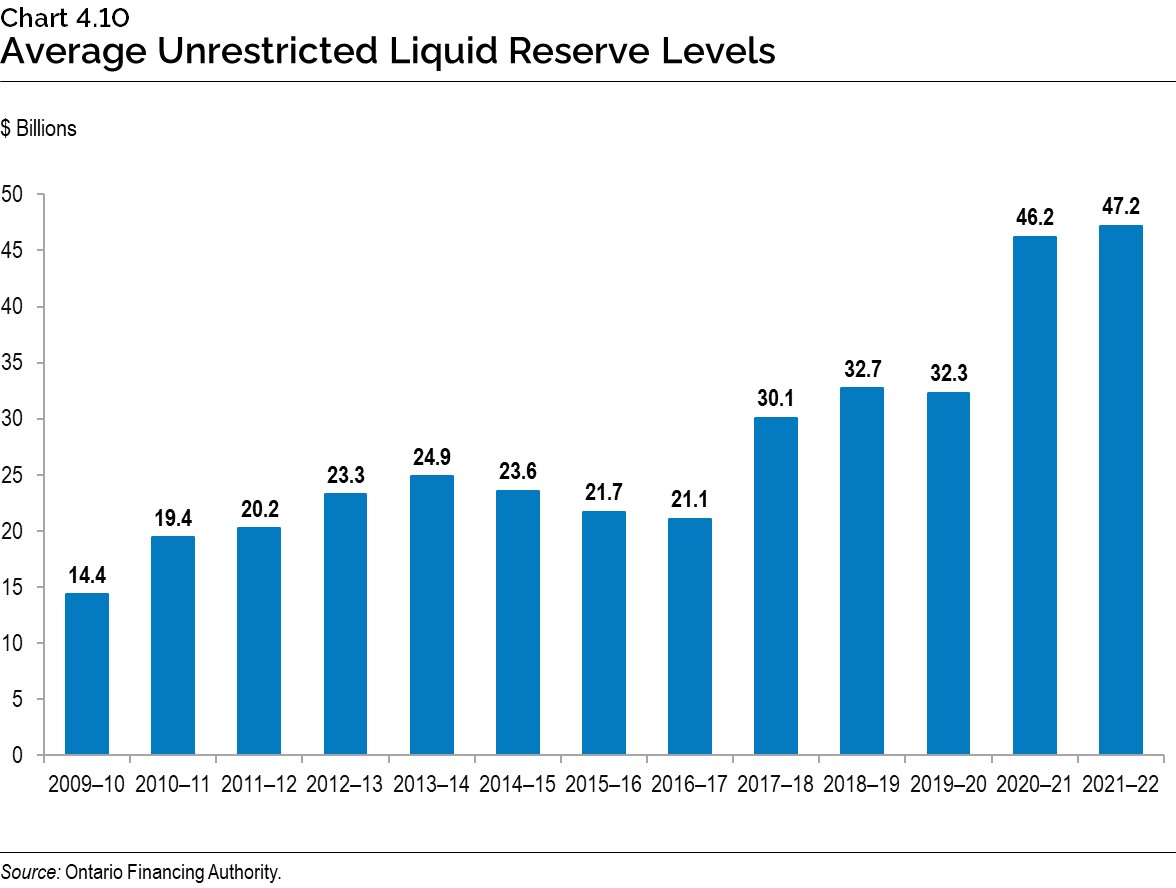
Debt Burden Reduction Strategy
The government remains committed to reducing the debt burden and putting Ontario’s finances back on a more sustainable path. In addition to a path to balance by 2027–28, two years earlier than projected in the 2021 Budget, Ontario has made positive progress towards each of the existing targets in its debt burden reduction strategy and added one new target.
Ontario’s 2021–22 net debt-to-GDP ratio is now forecast to be 40.7 per cent, a decrease of 8.1 percentage points from the forecasted 48.8 per cent at the time of the 2021 Budget. This was due to lower than previously projected deficits and higher nominal GDP growth. Ontario’s new target for the net debt-to-GDP ratio is to stay below 42.0 per cent over the medium-term outlook. This is down from the 2021 Budget target of 50.5 per cent, which reflected a high level of economic uncertainty as a result of the ongoing COVID-19 pandemic. Over the medium-term outlook, Ontario’s net debt-to-GDP in both 2022–23 and 2023–24 is now forecast to be 41.4 per cent, reducing to 41.3 per cent in 2024–25.
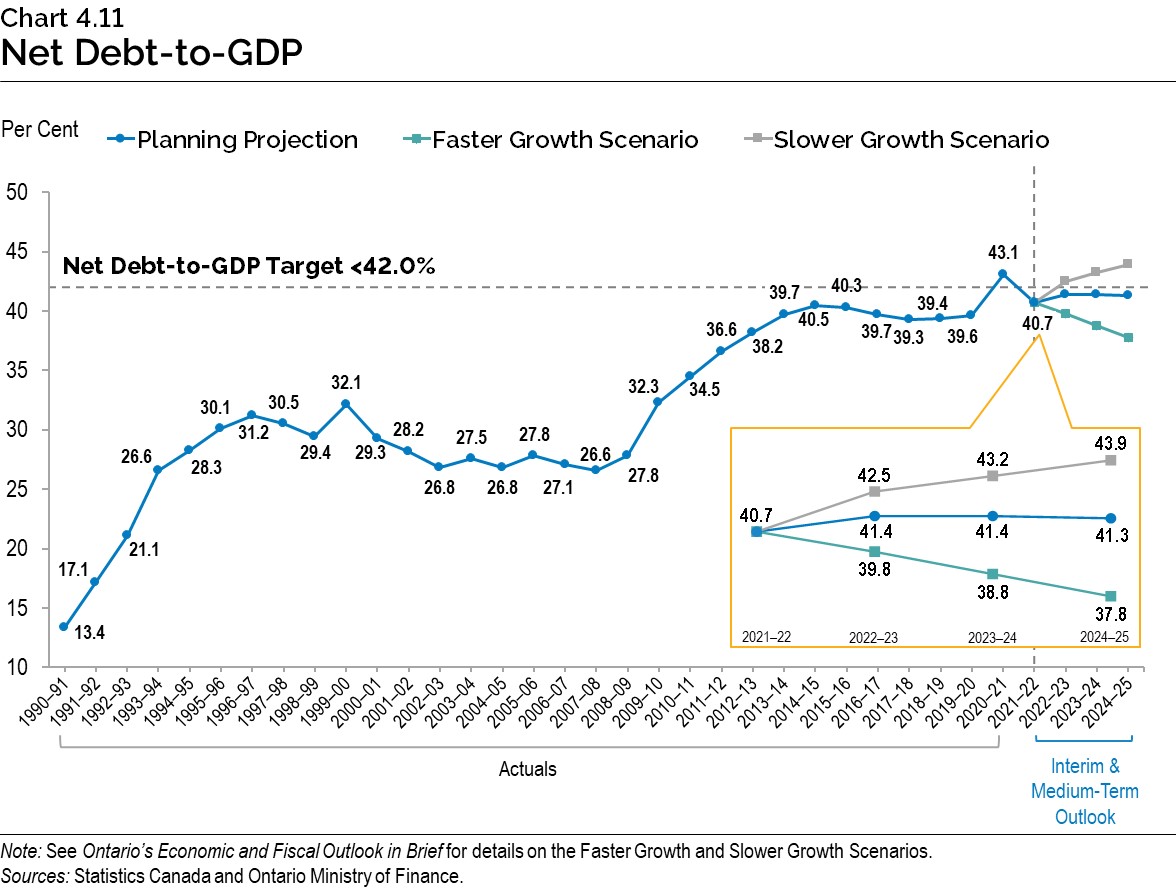
As of the 2021 Budget, in addition to net debt-to-GDP, the government began reporting on net debt-to-revenue and interest on debt-to-revenue as part of the overall debt burden reduction strategy.
The net debt-to-revenue ratio is projected to be 228 per cent in 2021–22, 58 percentage points below the 286 per cent forecast in the 2021 Budget. This ratio is an indicator of how many years it would take to eliminate the debt if the Ontario government were to spend all its annual revenue on debt repayment. Ontario’s objective in the 2021 Budget was to slow the rate of increase in the net debt-to-revenue ratio, supported by GDP growth. While this objective remains unchanged, it is now supported by a target for this ratio to stay below 250 per cent over the medium term. Over the medium–term outlook, this ratio is forecast to be 238 per cent in 2022–23, 239 per cent in 2023–24, and 238 per cent in 2024–25.
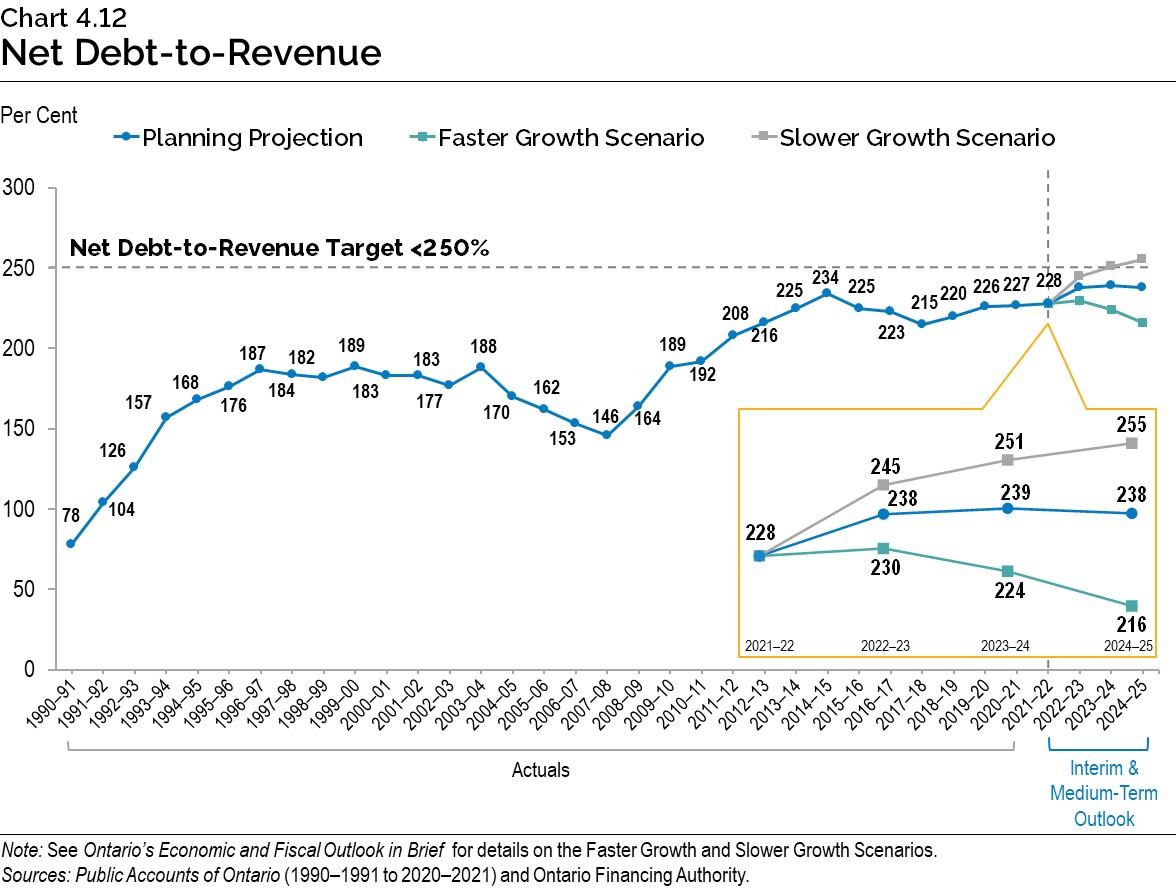
The IOD-to-revenue ratio is forecast to be 7.5 per cent in 2021–22, 1.0 percentage point lower than the 8.5 per cent forecast in the 2021 Budget. This ratio represents how much Ontario needs to spend on interest for every revenue dollar received. Ontario’s objective in the 2021 Budget was to slow the rate of increase in the IOD-to-revenue ratio, supported by GDP growth. While this objective remains unchanged, it is now supported by a target for this ratio to stay below 8.0 per cent over the medium-term outlook. Despite increases in deficits and borrowing requirements caused by the COVID-19 pandemic, IOD-to-revenue over the medium term continues to remain lower than forecasted in the pre-pandemic 2019 Budget. It is also lower over the medium-term outlook when compared to the forecast in the 2021 Budget, demonstrating the continued relative affordability of Ontario’s debt. This ratio is forecast to remain lower than its level last seen in the early 1990s.
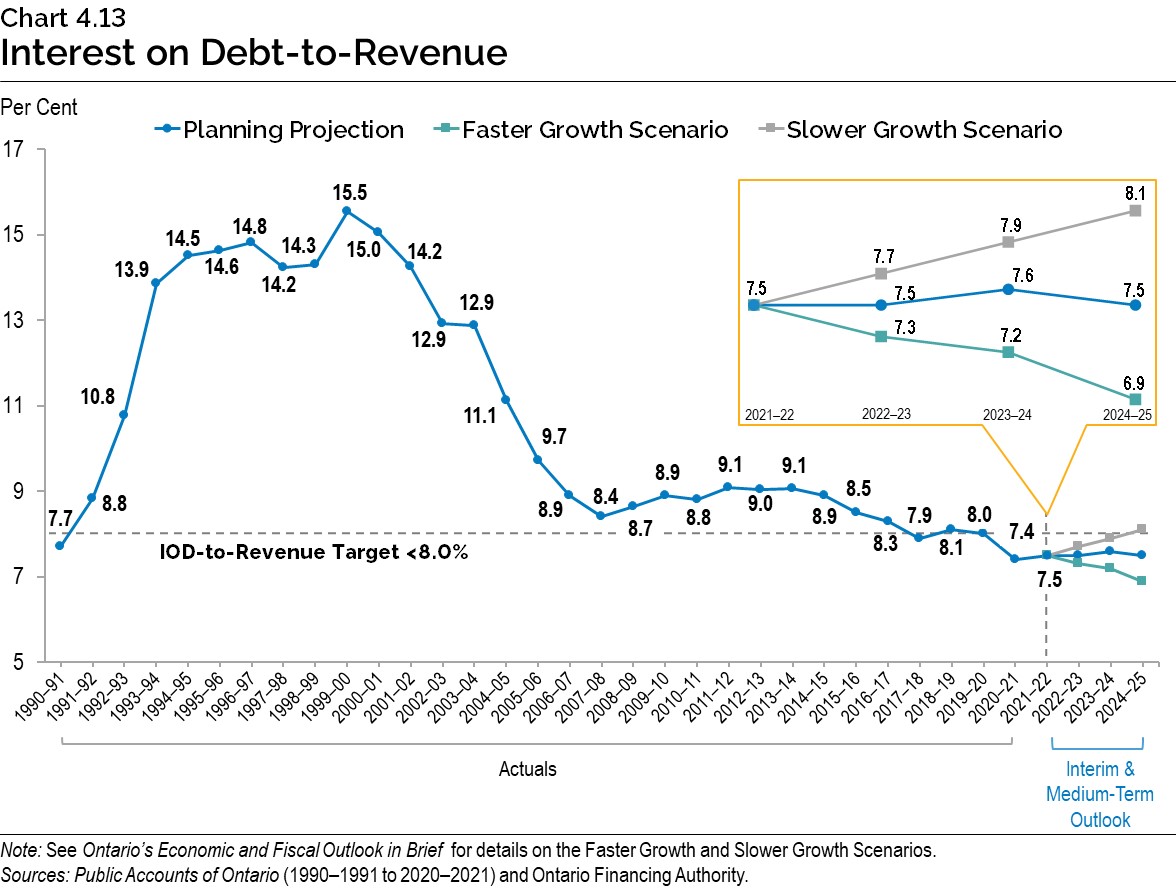
In response to the Office of the Auditor General of Ontario’s annual follow-up on value-for-money audit recommendations,1 Ontario is now introducing an additional relevant measure of debt sustainability in Ontario’s debt burden reduction strategy: debt maturities-to-net debt. This ratio represents long-term debt (debt three years and longer) maturing in any year, as a percentage of net debt. The current forecast is 6.3 per cent in 2021–22. Ontario’s specific target for the debt maturities-to-net debt ratio is to stay below 10.0 per cent.
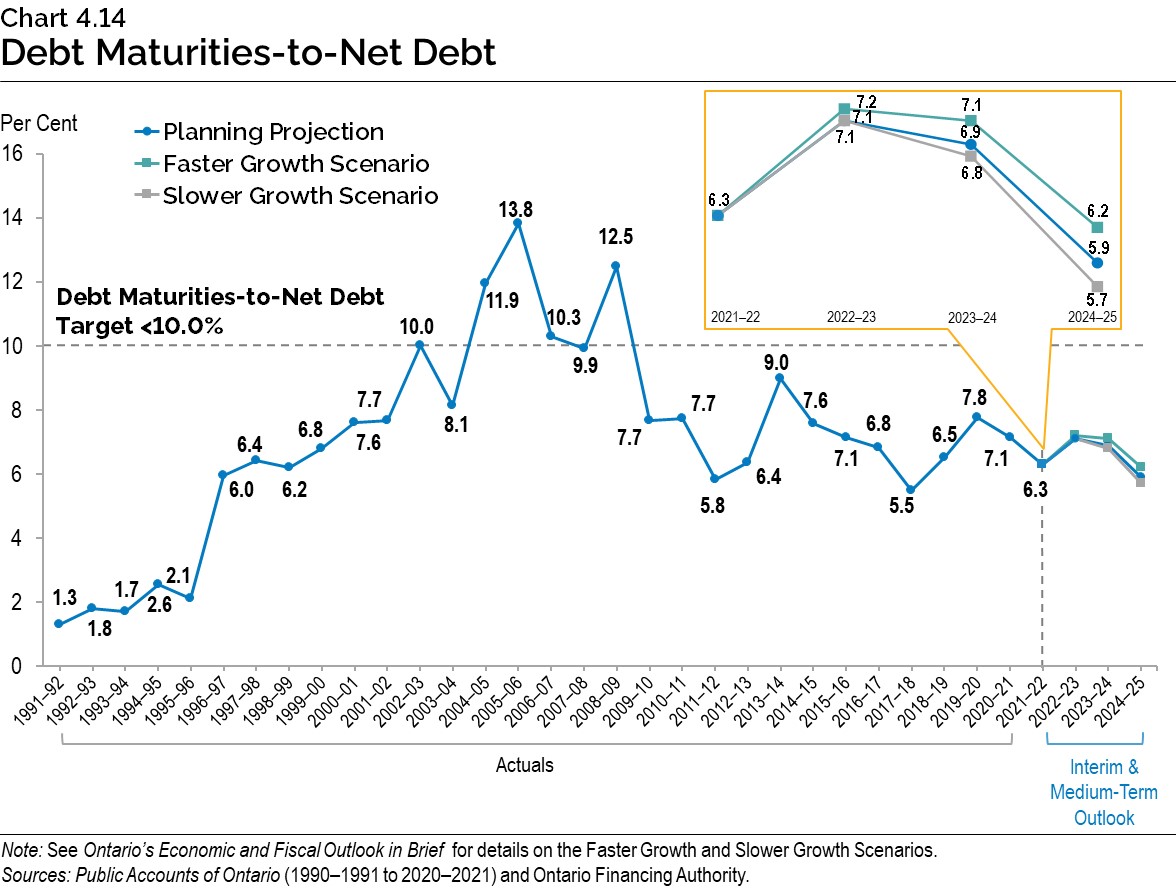
Consolidated Financial Tables
| Debt2 | 2017–18 | 2018–19 | 2019–20 | Actual 2020–21 |
Interim1 2021–22 |
Plan 2022–23 |
|---|---|---|---|---|---|---|
| Publicly Held Debt — Bonds3 | 315,247 | 334,940 | 349,088 | 382,169 | 400,259 | 411,237 |
| Publicly Held Debt — Treasury Bills | 17,528 | 17,546 | 19,175 | 24,097 | 23,425 | 26,425 |
| Publicly Held Debt — U.S. Commercial Paper4 | 3,865 | 3,863 | 3,891 | 0 | 672 | 672 |
| Publicly Held Debt — Infrastructure Ontario (IO)5 | 300 | 300 | 300 | 300 | 300 | 300 |
| Publicly Held Debt — Other | 287 | 292 | 264 | 250 | 231 | 217 |
| Total Publicly Held Debt | 337,227 | 356,941 | 372,718 | 406,816 | 424,887 | 438,851 |
| Non-Public Debt | 11,433 | 11,039 | 10,010 | 9,318 | 8,756 | 8,668 |
| Total Debt | 348,660 | 367,980 | 382,728 | 416,134 | 433,643 | 447,519 |
| Less: Holdings of Ontario bonds and treasury bills | (11,249) | (13,716) | (9,938) | (11,122) | (6,190) | (1,052) |
| Revised Total Debt | 337,411 | 354,264 | 372,790 | 405,012 | 427,453 | 446,467 |
| Cash and Temporary Investments Excluding Broader Public Sector6 | (20,097) | (26,250) | (25,140) | (34,505) | (41,343) | (36,229) |
| Total Debt Net of Cash and Temporary Investments | 317,314 | 328,014 | 347,650 | 370,507 | 386,110 | 410,238 |
| Other Net (Assets)/Liabilities7 | (6,791) | (3,422) | (8,217) | (9,505) | (2,656) | 7,735 |
| Broader Public Sector Net Debt | 13,311 | 13,904 | 13,899 | 12,562 | 11,479 | 10,680 |
| Net Debt | 323,834 | 338,496 | 353,332 | 373,564 | 394,933 | 428,653 |
| Non-Financial Assets8 | (114,811) | (121,854) | (127,568) | (134,270) | (142,143) | (152,277) |
| Accumulated Deficit | 209,023 | 216,642 | 225,764 | 239,294 | 252,790 | 276,376 |
Table 4.3 footnotes:
[1] Interim represents the 2022 Budget projection for the 2021–22 fiscal year.
[2] Includes debt issued by Ontario and all government organizations, including the Ontario Electricity Financial Corporation (OEFC).
[3], [4] All balances are expressed in Canadian dollars. The balances above reflect the effect of related derivative contracts.
[5] IO’s debt is composed of Infrastructure Renewal Bonds ($300 million). IO’s debt is not guaranteed by Ontario.
[6] Cash and temporary investments excludes any holdings in Ontario bonds and T-bills.
[7] Other Net (Assets)/Liabilities include accounts receivable, loans receivable, advances and investments in Government Business Enterprises (GBEs) offset by accounts payable, accrued liabilities, deferred revenue and capital contributions, pensions and other employee future benefits, and other liabilities.
[8] Non-financial assets include the tangible capital assets of Ontario including the broader public sector.
Sources: Ontario Financing Authority and Ontario Ministry of Finance.
| 2022–23 | 2023–24 | 2024–25 | |
|---|---|---|---|
| Total Debt | 447,519 | 464,355 | 475,477 |
| Cash and Temporary Investments | (37,281) | (37,281) | (37,281) |
| Total Debt Net of Cash and Temporary Investments | 410,238 | 427,074 | 438,196 |
| Other Net (Assets)/Liabilities | 7,735 | 12,345 | 16,991 |
| Broader Public Sector Net Debt | 10,680 | 11,008 | 13,618 |
| Net Debt | 428,653 | 450,427 | 468,805 |
| Non-Financial Assets | (152,277) | (161,719) | (172,516) |
| Accumulated Deficit | 276,376 | 288,708 | 296,289 |
Table 4.4 footnotes:
Source: Ontario Ministry of Finance.
Footnotes
[1] Office of the Auditor General of Ontario, Annual Follow-Up on Value-for-Money Audits Chapter 1, (2021), https://www.auditor.on.ca/en/content/annualreports/arreports/en21/1-10OFS_en21.pdf
Chart Descriptions
Chart 4.1: Borrowing Outlook Scenarios for Long-Term Borrowing
($ Billions)
| Year | 2021–22 | 2022–23 | 2023–24 | 2024–25 |
|---|---|---|---|---|
| Planning Projection | $41.1 | $41.5 | $44.6 | $38.9 |
| Slower Growth Scenario | $41.1 | $44.8 | $50.1 | $46.3 |
| Faster Growth Scenario | $41.1 | $36.6 | $37.2 | $28.8 |
Sources: Ontario Financing Authority and Ontario Ministry of Finance.
Chart 4.2: 2021–22 Borrowing
Long-term public borrowing of $41.1 billion has been completed for fiscal year 2021–22. This consisted of $26.8 billion (65 per cent) of Canadian dollar syndicated bonds, $4.4 billion (11 per cent) of Canadian dollar Green Bond*, $0.8 billion (2 per cent) in Canadian dollar bond auction, $6.9 billion (17 per cent) of U.S. dollar bonds, $1.8 billion (4 per cent) of euro bonds, $0.3 billion (1 per cent) of Swiss franc bond, and $0.1 billion (<1 per cent) of Australian dollar bonds.
* Face value $4.5 billion
Note: Numbers may not add due to rounding.
Source: Ontario Financing Authority.
Chart 4.3: Domestic and International Borrowing
Ontario’s total long-term borrowing completed in 2021–22 is forecast to be $41.1 billion — $32.0 billion was borrowed in the Canadian dollar market and $9.2 billion was borrowed in foreign currencies.
| Year | Canadian Dollar ($ Billions) | Foreign Currencies ($ Billions) | Total ($ Billions) |
|---|---|---|---|
| 2007–08 | 15.4 | 2.6 | 18.0 |
| 2008–09 | 19.0 | 9.7 | 28.7 |
| 2009–10 | 21.4 | 22.4 | 43.8 |
| 2010–11 | 23.5 | 16.4 | 39.9 |
| 2011–12 | 28.4 | 6.5 | 34.9 |
| 2012–13 | 26.4 | 10.2 | 36.6 |
| 2013–14 | 29.4 | 6.6 | 36.0 |
| 2014–15 | 31.4 | 8.4 | 39.9 |
| 2015–16 | 25.8 | 6.3 | 32.1 |
| 2016–17 | 19.9 | 7.1 | 27.0 |
| 2017–18 | 21.1 | 12.8 | 33.9 |
| 2018–19 | 30.6 | 9.0 | 39.6 |
| 2019–20 | 28.9 | 10.6 | 39.5 |
| 2020–21 | 39.1 | 20.7 | 59.8 |
| 2021–22 | 32.0 | 9.2 | 41.1 |
Note: Numbers may not add due to rounding.
Source: Ontario Financing Authority.
Chart 4.4: Green Bond Allocation by Framework Category
A total of $12.5 billion in Green Bond funding has provided funding for 28 projects. Eight of those projects are under the Clean Transportation framework category and have received 77 per cent of the funding. Nineteen projects are under the Energy Efficiency and Conservation category and have received 20 per cent of the funding. One project is under the Climate Adaptation and Resilience category and has received three per cent of the funding.
Note: Numbers may not add due to rounding.
Source: Ontario Financing Authority.
Chart 4.5: Ontario’s Green Bond Issues
Since 2014, Ontario has issued Green Bonds totalling $12.5 billion.
| Year | 2014–15 | 2015–16 | 2016–17 | 2017–18 | 2018–19 | 2019–20 | 2020–21 | 2021–22 |
|---|---|---|---|---|---|---|---|---|
| Green Bond Issues ($) | $500 million | $750 million | $800 million | $1.0 billion | $950 million | $1.25 billion | $2.75 billion | $4.5 billion |
Source: Ontario Financing Authority.
Chart 4.6: Effective Interest Rate (Weighted Average) on Total Debt
As of March 31, 2022, the effective interest rate (calculated as a weighted average) for fiscal year-end is forecast to be 3.0 per cent on Ontario’s total debt.
| Year | Effective Interest Rate (%) |
|---|---|
| 1990–91 | 10.9 |
| 1991–92 | 10.7 |
| 1992–93 | 10.1 |
| 1993–94 | 9.5 |
| 1994–95 | 9.8 |
| 1995–96 | 9.4 |
| 1996–97 | 9.0 |
| 1997–98 | 9.0 |
| 1998–99 | 8.6 |
| 1999–00 | 8.4 |
| 2000–01 | 8.2 |
| 2001–02 | 7.6 |
| 2002–03 | 7.2 |
| 2003–04 | 6.7 |
| 2004–05 | 6.4 |
| 2005–06 | 6.1 |
| 2006–07 | 6.0 |
| 2007–08 | 5.8 |
| 2008–09 | 5.2 |
| 2009–10 | 4.6 |
| 2010–11 | 4.5 |
| 2011–12 | 4.4 |
| 2012–13 | 4.1 |
| 2013–14 | 3.9 |
| 2014–15 | 3.7 |
| 2015–16 | 3.6 |
| 2016–17 | 3.5 |
| 2017–18 | 3.6 |
| 2018–19 | 3.6 |
| 2019–20 | 3.4 |
| 2020–21 | 3.0 |
| 2021–22 | 3.0 |
Sources: Public Accounts of Ontario (1990–1991 to 2020–2021) and Ontario Financing Authority.
Chart 4.7: Comparison of Average Annual Ontario Borrowing Rates
| Year | 2021 Budget(%) | 2022 Budget (%) |
|---|---|---|
| 2021–22 | 1.90 | 2.10 |
| 2022–23 | 2.40 | 3.40 |
| 2023–24 | 3.20 | 3.60 |
| 2024–25 | – | 4.10 |
Source: Ontario Financing Authority.
Chart 4.8: Comparison of Interest on Debt Expense Forecast
| Year | 2022 Budget ($ Billions) | 2021 Budget ($ Billions) |
|---|---|---|
| 2021–22 | 13.0 | 13.1 |
| 2022–23 | 13.5 | 13.7 |
| 2023–24 | 14.3 | 14.6 |
| 2024–25 | 14.9 | ― |
Source: Ontario Ministry of Finance.
Chart 4.9: Weighted-Average Term of Borrowings
The average term of Ontario’s debt portfolio has been extended from 9.7 years in 2009–10 to 10.9 years in 2021–22. The weighted-average borrowing term for 2021–22 was 14.5 years as of March 31, 2022.
| Year | 2009–10 | 2010–11 | 2011–12 | 2012–13 | 2013–14 | 2014–15 | 2015–16 | 2016–17 | 2017–18 | 2018–19 | 2019–20 | 2020–21 | 2021–22 |
|---|---|---|---|---|---|---|---|---|---|---|---|---|---|
| Weighted-Average Borrowing Term (Years) | 8.1 | 12.8 | 13.0 | 12.4 | 13.6 | 14.1 | 14.2 | 13.9 | 12.1 | 12.9 | 14.5 | 12.0 | 14.5 |
| Debt Portfolio Average Term (Years) | 9.7 | 10.0 | 10.1 | 10.1 | 10.4 | 10.7 | 10.9 | 10.9 | 10.7 | 10.7 | 10.9 | 10.8 | 10.9 |
Source: Ontario Financing Authority.
Chart 4.10: Average Unrestricted Liquid Reserve Levels
Average unrestricted liquid reserve levels are forecast to be $47.2 billion as of March 31, 2022.
| Year | Average Unrestricted Liquid Reserve Levels ($ billions) |
|---|---|
| 2009–10 | 14.4 |
| 2010–11 | 19.4 |
| 2011–12 | 20.2 |
| 2012–13 | 23.3 |
| 2013–14 | 24.9 |
| 2014–15 | 23.6 |
| 2015–16 | 21.7 |
| 2016–17 | 21.1 |
| 2017–18 | 30.1 |
| 2018–19 | 32.7 |
| 2019–20 | 32.3 |
| 2020–21 | 46.2 |
| 2021–22 | 47.2 |
Source: Ontario Financing Authority.
Chart 4.11: Net Debt-to-GDP
Ontario’s net debt-to-GDP ratio is forecast at 41.4 per cent in 2022–23.
| Year | Planning Projection (%) | Faster Growth Scenario (%) | Slower Growth Scenario (%) |
|---|---|---|---|
| 1990–91 | 13.4 | – | – |
| 1991–92 | 17.1 | – | – |
| 1992–93 | 21.1 | – | – |
| 1993–94 | 26.6 | – | – |
| 1994–95 | 28.3 | – | – |
| 1995–96 | 30.1 | – | – |
| 1996–97 | 31.2 | – | – |
| 1997–98 | 30.5 | – | – |
| 1998–99 | 29.4 | – | – |
| 1999–00 | 32.1 | – | – |
| 2000–01 | 29.3 | – | – |
| 2001–02 | 28.2 | – | – |
| 2002–03 | 26.8 | – | – |
| 2003–04 | 27.5 | – | – |
| 2004–05 | 26.8 | – | – |
| 2005–06 | 27.8 | – | – |
| 2006–07 | 27.1 | – | – |
| 2007–08 | 26.6 | – | – |
| 2008–09 | 27.8 | – | – |
| 2009–10 | 32.3 | – | – |
| 2010–11 | 34.5 | – | – |
| 2011–12 | 36.6 | – | – |
| 2012–13 | 38.2 | – | – |
| 2013–14 | 39.7 | – | – |
| 2014–15 | 40.5 | – | – |
| 2015–16 | 40.3 | – | – |
| 2016–17 | 39.7 | – | – |
| 2017–18 | 39.3 | – | – |
| 2018–19 | 39.4 | – | – |
| 2019–20 | 39.6 | – | – |
| 2020–21 | 43.1 | – | – |
| 2021–22 | 40.7 | – | – |
| 2022–23 | 41.4 | 39.8 | 42.5 |
| 2023–24 | 41.4 | 38.8 | 43.2 |
| 2024–25 | 41.3 | 37.8 | 43.9 |
Note: See Ontario’s Economic and Fiscal Outlook in Brief for details on the Faster Growth and Slower Growth Scenarios.
Sources: Statistics Canada and Ontario Ministry of Finance.
Chart 4.12: Net Debt-to-Revenue
Ontario’s net debt-to-revenue ratio is forecast to be 238 per cent in 2022–23.
| Year | Planning Projection (%) | Faster Growth Scenario (%) | Slower Growth Scenario (%) |
|---|---|---|---|
| 1990–91 | 78 | – | – |
| 1991–92 | 104 | – | – |
| 1992–93 | 126 | – | – |
| 1993–94 | 157 | – | – |
| 1994–95 | 168 | – | – |
| 1995–96 | 176 | – | – |
| 1996–97 | 187 | – | – |
| 1997–98 | 184 | – | – |
| 1998–99 | 182 | – | – |
| 1999–00 | 189 | – | – |
| 2000–01 | 183 | – | – |
| 2001–02 | 183 | – | – |
| 2002–03 | 177 | – | – |
| 2003–04 | 188 | – | – |
| 2004–05 | 170 | – | – |
| 2005–06 | 162 | – | – |
| 2006–07 | 153 | – | – |
| 2007–08 | 146 | – | – |
| 2008–09 | 164 | – | – |
| 2009–10 | 189 | – | – |
| 2010–11 | 192 | – | – |
| 2011–12 | 208 | – | – |
| 2012–13 | 216 | – | – |
| 2013–14 | 225 | – | – |
| 2014–15 | 234 | – | – |
| 2015–16 | 225 | – | – |
| 2016–17 | 223 | – | – |
| 2017–18 | 215 | – | – |
| 2018–19 | 220 | – | – |
| 2019–20 | 226 | – | – |
| 2020–21 | 227 | – | – |
| 2021–22 | 228 | – | – |
| 2022–23 | 238 | 230 | 245 |
| 2023–24 | 239 | 224 | 251 |
| 2024–25 | 238 | 216 | 255 |
Note: See Ontario’s Economic and Fiscal Outlook in Brief for details on the Faster Growth and Slower Growth Scenarios.
Sources: Public Accounts of Ontario (1990–1991 to 2020–2021) and Ontario Financing Authority.
Chart 4.13: Interest on Debt-to-Revenue
Ontario’s interest on debt-to-revenue ratio is forecast to be 7.5 per cent in 2022–23.
| Year | Planning Projection (%) | Faster Growth Scenario (%) | Slower Growth Scenario (%) |
|---|---|---|---|
| 1990–91 | 7.7 | – | – |
| 1991–92 | 8.8 | – | – |
| 1992–93 | 10.8 | – | – |
| 1993–94 | 13.9 | – | – |
| 1994–95 | 14.5 | – | – |
| 1995–96 | 14.6 | – | – |
| 1996–97 | 14.8 | – | – |
| 1997–98 | 14.2 | – | – |
| 1998–99 | 14.3 | – | – |
| 1999–00 | 15.5 | – | – |
| 2000–01 | 15.0 | – | – |
| 2001–02 | 14.2 | – | – |
| 2002–03 | 12.9 | – | – |
| 2003–04 | 12.9 | – | – |
| 2004–05 | 11.1 | – | – |
| 2005–06 | 9.7 | – | – |
| 2006–07 | 8.9 | – | – |
| 2007–08 | 8.4 | – | – |
| 2008–09 | 8.7 | – | – |
| 2009–10 | 8.9 | – | – |
| 2010–11 | 8.8 | – | – |
| 2011–12 | 9.1 | – | – |
| 2012–13 | 9.0 | – | – |
| 2013–14 | 9.1 | – | – |
| 2014–15 | 8.9 | – | – |
| 2015–16 | 8.5 | – | – |
| 2016–17 | 8.3 | – | – |
| 2017–18 | 7.9 | – | – |
| 2018–19 | 8.1 | – | – |
| 2019–20 | 8.0 | – | – |
| 2020–21 | 7.4 | – | – |
| 2021–22 | 7.5 | – | – |
| 2022–23 | 7.5 | 7.3 | 7.7 |
| 2023–24 | 7.6 | 7.2 | 7.9 |
| 2024–25 | 7.5 | 6.9 | 8.1 |
Note: See Ontario’s Economic and Fiscal Outlook in Brief for details on the Faster Growth and Slower Growth Scenarios.
Sources: Public Accounts of Ontario (1990–1991 to 2020–2021) and Ontario Financing Authority.
Chart 4.14: Debt Maturities-to-Net Debt
Ontario’s debt maturities-to-net debt ratio is forecast to be 7.1 per cent in 2022–23.
| Year | Planning Projection (%) | Faster Growth Scenario (%) | Slower Growth Scenario (%) |
|---|---|---|---|
| 1991–92 | 1.3 | – | – |
| 1992–93 | 1.8 | – | – |
| 1993–94 | 1.7 | – | – |
| 1994–95 | 2.6 | – | – |
| 1995–96 | 2.1 | – | – |
| 1996–97 | 6.0 | – | – |
| 1997–98 | 6.4 | – | – |
| 1998–99 | 6.2 | – | – |
| 1999–00 | 6.8 | – | – |
| 2000–01 | 7.6 | – | – |
| 2001–02 | 7.7 | – | – |
| 2002–03 | 10.0 | – | – |
| 2003–04 | 8.1 | – | – |
| 2004–05 | 11.9 | – | – |
| 2005–06 | 13.8 | – | – |
| 2006–07 | 10.3 | – | – |
| 2007–08 | 9.9 | – | – |
| 2008–09 | 12.5 | – | – |
| 2009–10 | 7.7 | – | – |
| 2010–11 | 7.7 | – | – |
| 2011–12 | 5.8 | – | – |
| 2012–13 | 6.4 | – | – |
| 2013–14 | 9.0 | – | – |
| 2014–15 | 7.6 | – | – |
| 2015–16 | 7.1 | – | – |
| 2016–17 | 6.8 | – | – |
| 2017–18 | 5.5 | – | – |
| 2018–19 | 6.5 | – | – |
| 2019–20 | 7.8 | – | – |
| 2020–21 | 7.1 | – | – |
| 2021–22 | 6.3 | – | – |
| 2022–23 | 7.1 | 7.2 | 7.1 |
| 2023–24 | 6.9 | 7.1 | 6.8 |
| 2024–25 | 5.9 | 6.2 | 5.7 |
Note: See Ontario’s Economic and Fiscal Outlook in Brief for details on the Faster Growth and Slower Growth Scenarios.
Sources: Public Accounts of Ontario (1990–1991 to 2020–2021) and Ontario Financing Authority.